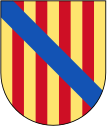
In heraldry, variations of the field are any of a number of ways that a field may be covered with a pattern, rather than a flat tincture or a simple division of the field.

The national flag of Spain, as it is defined in the Constitution of 1978, consists of three horizontal stripes: red, yellow and red, the yellow stripe being twice the height of each red stripe. Traditionally, the middle stripe was defined by the more archaic term of gualda, and hence the popular name la Rojigualda (red-weld).

In heraldry, an ordinary is one of the two main types of charges, beside the mobile charges. An ordinary is a simple geometrical figure, bounded by straight lines and running from side to side or top to bottom of the shield. There are also some geometric charges known as subordinaries, which have been given lesser status by some heraldic writers, though most have been in use as long as the traditional ordinaries. Diminutives of ordinaries and some subordinaries are charges of the same shape, though thinner. Most of the ordinaries are theoretically said to occupy one-third of the shield; but this is rarely observed in practice, except when the ordinary is the only charge.

The coat of arms of Spain represents Spain and the Spanish nation, including its national sovereignty and the country's form of government, a constitutional monarchy. It appears on the flag of Spain and it is used by the Government of Spain, the Cortes Generales, the Constitutional Court, the Supreme Court, and other state institutions. Its design consists of the arms of the medieval kingdoms that would unite to form Spain in the 15th century, the Royal Crown, the arms of the House of Bourbon, the Pillars of Hercules and the Spanish national motto: Plus Ultra. The monarch, the heir to the throne and some institutions like the Senate, the Council of State and the General Council of the Judiciary have their own variants of the coat of arms.

The coat of arms of the King of Spain is the heraldic symbol representing the monarch of Spain. The current version of the monarch's coat of arms was adopted in 2014 but is of much older origin. The arms marshal the arms of the former monarchs of Castile, León, Aragon, and Navarre.

The blazon of the coat of arms of the Princess of Asturias is given by a Royal Decree 979 on 30 October 2015 which was an amendment of the Royal Decree 1511 dated Madrid 21 January 1977, which also created her guidon and her standard.

In heraldry and heraldic vexillology, a blazon is a formal description of a coat of arms, flag or similar emblem, from which the reader can reconstruct the appropriate image. The verb to blazon means to create such a description. The visual depiction of a coat of arms or flag has traditionally had considerable latitude in design, but a verbal blazon specifies the essentially distinctive elements. A coat of arms or flag is therefore primarily defined not by a picture but rather by the wording of its blazon. Blazon is also the specialized language in which a blazon is written, and, as a verb, the act of writing such a description. Blazonry is the art, craft or practice of creating a blazon. The language employed in blazonry has its own vocabulary, grammar and syntax, which becomes essential for comprehension when blazoning a complex coat of arms.

The coat of arms of Galicia is described in the Spanish Law 5 of 29 May 1984, the Law of the symbols of Galicia.

Charles V, Holy Roman Emperor was the heir of several of Europe's leading royal houses. In 1506, he inherited the Burgundian Netherlands, which came from his paternal grandmother, Mary of Burgundy. In 1516, Charles became the king of Spain, inheriting the kingdoms first united by his maternal grandparents, Isabella I of Castile and Ferdinand II of Aragon. Finally, on the death of his paternal grandfather in 1519, Maximilian I, Holy Roman Emperor, he inherited the Habsburg lands in central Europe and was elected Holy Roman Emperor.

The coat of arms of the Extremadura is described in the Title I of the Spanish Law 4 of June 3, 1985, the Law of the coat of arms, flag and regional day of Extremadura.
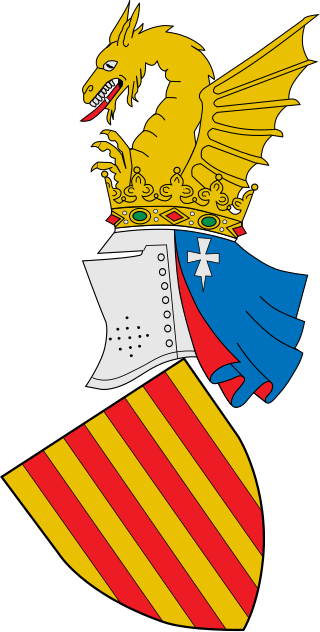
The coat of arms of the Valencian Community is the official emblem of the self-government institutions of the Valencian Community. It is based on the armorial achievement used from the reign of King Peter IV to John II, called the Great. In 1978 the former Council of the Valencian Country approved it “...for being the oldest known representative emblem of the former Kingdom of Valencia, that had located on the Xerea Gate of the city of Valencia”.

The so-called Bars of Aragon, Royal sign of Aragon, Royal arms of Aragon, Four Bars, Red Bars or Coat of arms of the Crown of Aragon, which bear four red pallets on gold background, depicts the familiar coat of the Kings of Aragon. It differs from the flag because this latter instead uses bars. It is one of the oldest coats of arms in Europe dating back to a seal of Raymond Berengar IV, Count of Barcelona and Prince of Aragon, from 1150.
The Spanish monarchs of the House of Habsburg and Philip V used separate versions of their royal arms as sovereigns of the Kingdom of Naples-Sicily, Sardinia and the Duchy of Milan with the arms of these territories.

The Eagle of Saint John is a heraldic eagle associated mostly with the Catholic Monarchs which was later used during Francoist Spain (1939–77) and the Spanish transition to democracy (1977–81). It is sable with an or halo and feet of gules.
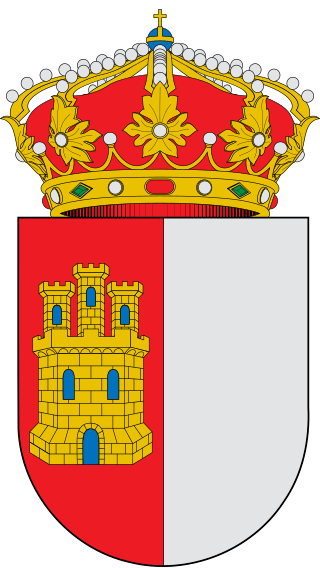
The coat of arms of the Castilla–La Mancha is described in the Spanish Law 1 of 30 June 1983, the Law of the coat of arms of Castilla-La Mancha Region and further regulated by Decree 132 of 5 July 1983, approving the official design of the coat of arms of Castilla-La Mancha and Decree 115 of 12 November 1985, supplementing Decree 132/1983.

The coat of arms of the Region of Murcia is described in the article 4 of the Spanish Organic Law 4 of 9 June 1982, the Statute of Autonomy of the Region of Murcia and further regulated by Decree 34 of 8 June 1983, approving the official design and use of the coat of arms of the Region of Murcia.
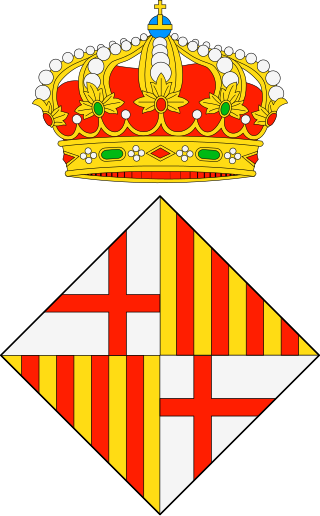
The coat of arms of Barcelona is the official emblem of the City Council of Barcelona, the capital of Catalonia, has its origin in the Middle Ages, these arms were first documented in 1329. The Government of Catalonia conferred the coat of arms and the flag as official symbols of the municipality in 2004. It has an escutcheon in lozenge which is commonly used in municipal coats of arms of cities in Catalonia. Currently the City Council of Barcelona also uses an isotype based on the heraldry of the city.
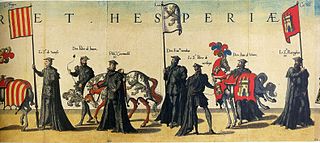
The first instance of a figure of the lion as symbol of the Kingdom of León is found in minted coins of Alfonso VII, called the Emperor (1126–1157). Until then, the cross had a preponderant position on documents and coins of Leonese monarchs since that reign the cross was gradually displaced by the lion. The Spanish historian and heraldist Martín de Riquer explained that the lion was already used as heraldic emblem in 1148. At the end of the reign of Alfonso VII, the figure of this animal began to appear on royal documents as personal device of the monarch and became pervasive during reigns of Ferdinand II (1157-1188) and Alfonso IX (1188-1230).

The coat of arms of Castile was the heraldic emblem of its monarchs. Historian Michel Pastoureau says that the original purpose of heraldic emblems and seals was to facilitate the exercise of power and the identification of the ruler, due to what they offered for achieving these aims. These symbols were associated with the kingdom, and eventually also represented the intangible nature of the national sentiment or sense of belonging to a territory.

The coat of arms of Santiago de Compostela represents Santiago de Compostela, in the province of A Coruña, Galicia, Spain. The coat of arms combines Galician heraldry with traditions related to the city of Santiago de Compostela.

